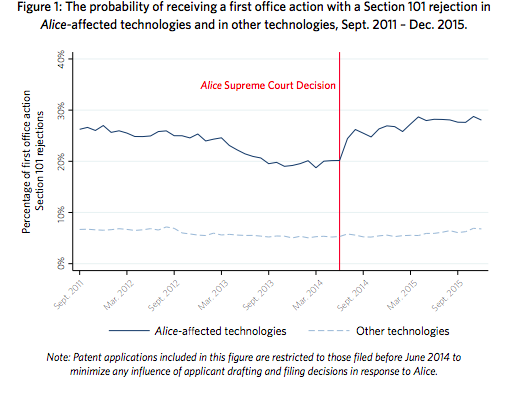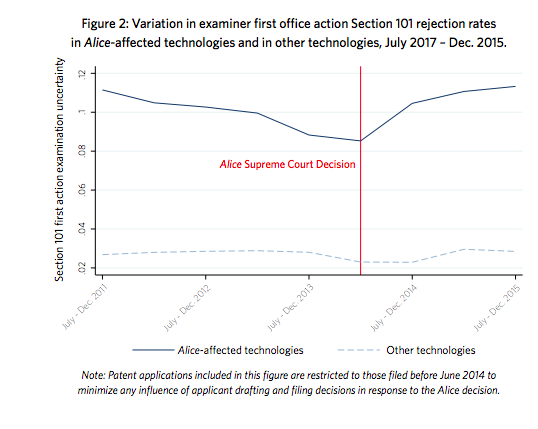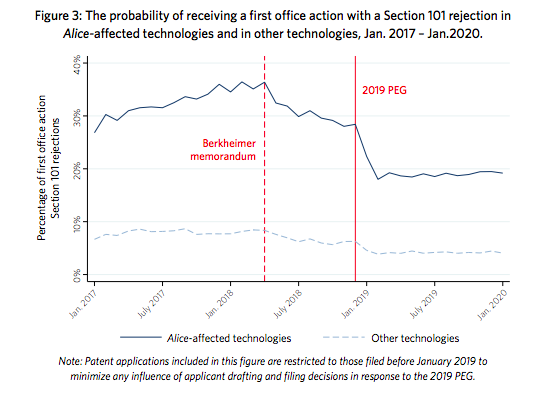“Many in the patent community have championed the 2019 Section 101 Eligibility Guidelines and the so-called ‘Iancu-effect,’ referring to the Director’s various actions to restore predictability on Section 101. However, without the Federal Circuit and Supreme Court supporting those efforts, what do these results mean?”
The United States Patent and Trademark Office (USPTO) Chief Economist today released a report, “Adjusting to Alice: USPTO patent examination outcomes after Alice Corp v. CLS Bank International,” outlining the effect of recent USPTO actions on patent eligibility determinations in certain technology areas most affected by the Alice decision.
According to a USPTO press release, the conclusion is that these actions “have brought greater predictability and certainty” to these tech areas.
“We have heard anecdotally from both examiners and applicants across the entire spectrum of technologies that our 2019 guidance on Section 101 greatly improved the analysis in this important area of patent law,” said Andrei Iancu, Under Secretary of Commerce for Intellectual Property and Director of the USPTO in the press release. “The Chief Economist’s report now confirms this general perception, especially with its critical finding that uncertainty decreased by a remarkable 44%.”
Here are some of the key findings from the report:
- The likelihood of receiving a first office action with a rejection for patent-ineligible subject matter increased by 31% in the 18 months following the U.S. Supreme Court decision in Alice Corp. v. CLS Bank International in 33 “Alice-affected” technology areas.
- For these technologies, uncertainty in patent examination — measured as variability in patent subject matter eligibility determinations across examiners in the first action stage of examination — increased by 26% in the 18 months following the Alice
- One year after the Office issued its January 2019 Revised Patent Subject Matter Eligibility Guidance (2019 PEG), the likelihood of Alice-affected technologies receiving a first office action with a rejection for patent-ineligible subject matter had decreased by 25%.
- Uncertainty in patent examination for Alice-affected technologies decreased by 44% in the 12 months following the issuance of the 2019 PEG.
And this is how the Office identified “Alice-affected” technologies, from the report’s Appendix:
To identify Alice-affected technologies, we use information compiled by the USPTO’s Office of Patent Legal Administration (OPLA) on patent litigation cases from the U.S. Court of Appeals for the Federal Circuit and the U.S. Supreme Court that involved patent subject matter eligibility.18 OPLA documents the patents in-suit, as well as the relevant judicial exception for each case reviewed. The United States Patent Classifications (USPCs) of the patent applications litigated for “abstract ideas” form the set of Alice-affected technologies.19 Our control set of technologies (called “other technologies” in our figures) includes all USPCs that were never involved in patent litigation for Section 101 issues according to OPLA’s records.
According to the report, the increase in first office action Section 101 rejections following the Alice decision “persisted until the USPTO’s April 2018 memorandum titled ‘Change in Examination Procedure Pertaining to Subject Matter Eligibility, Recent Subject Matter Eligibility Decision’ (Berkheimer 13 Berkheimer v. HP Inc., 881 F.3d 1360 (Fed. Cir. 2018) (the Berkheimer memorandum) and the USPTO’s subsequent January 2019 Revised Patent Subject Matter Eligibility Guidance (2019 PEG).”
Many in the patent community have championed the 2019 Eligibility Guidelines and the so-called “Iancu-effect,” referring to the Director’s various actions to restore predictability on Section 101. However, without the Federal Circuit and Supreme Court supporting those efforts, the results outlined in this report may arguably mean little. In February 2019, IPWatchdog Founder and CEO Gene Quinn wrote:
There is great optimism among patent owners and innovators that things are changing and will continue to improve at the USPTO under Director Iancu’s guidance. The question that remains for patent industry observers is whether the Federal Circuit will ultimately agree with what Director Iancu is doing in order to implement predictability.
So far, it has not, and the Supreme Court has declined to intervene.
The report’s author, Dr. Andrew Toole, USPTO Chief Economist, said in the USPTO press release:
The primary economic function of the patent system is to provide an incentive for greater innovation. Using an evidence-based approach, our report highlights the significant impact of the Supreme Court’s Alice decision on patent examination outcomes and the important stabilizing role played by the USPTO. This is what innovators and investors need to confidently promote entrepreneurship, create jobs, and advance science and technology.
Director Iancu added:
I have long said that in order to ensure that the United States remains the global leader in the technologies of the future, our patent system must move beyond the recent years of confusion and unpredictability on subject matter eligibility. It is now clear that our recent guidelines mark a significant step in that direction, and I ask all involved in our treasured patent system to come together and solve, once and for all, this fundamental issue.

Source: USPTO report

Source: USPTO report

Source: USPTO report

![[IPWatchdog Logo]](https://ipwatchdog.com/wp-content/themes/IPWatchdog%20-%202023/assets/images/temp/logo-small@2x.png)

![[Advertisement]](https://ipwatchdog.com/wp-content/uploads/2024/04/Patent-Litigation-Masters-2024-sidebar-700x500-1.jpg)

![[Advertisement]](https://ipwatchdog.com/wp-content/uploads/2021/12/WEBINAR-336-x-280-px.png)
![[Advertisement]](https://ipwatchdog.com/wp-content/uploads/2021/12/2021-Patent-Practice-on-Demand-recorded-Feb-2021-336-x-280.jpg)
![[Advertisement]](https://ipwatchdog.com/wp-content/uploads/2021/12/Ad-4-The-Invent-Patent-System™.png)






Join the Discussion
9 comments so far.
Anon
April 30, 2020 08:49 amFigure 3 and the apparent 20% that will NOT change….
What is being done about that recalcitrance?
Concerned
April 27, 2020 05:17 pmJT:
Application 14450042.
You will note, among other things, that the examiner readily admits the process solves a problem that has been beyond the reach of working professionals and experts since the program existence of July 1956.
Another puzzling factor is the examiner calls the process well understood, routine and conventional when documents were submitted on the official record from every Medicaid authority in the nation and the Social Security Administration proving that nobody does my inventive concept, either individually or in combination.
The examiner also states the solution simply automates a manual process. There has never been a manual process to automate or expedite, nor did the examiner offer proof of such a manual process.
The author of “The Plight of the Patentee” reached out for my story as well as IPWatchdog. Since these publications, the prosecution has become even more bizarre.
Other people across the nation have also been supportive and helpful.
Thank you for your interest.
JT
April 27, 2020 09:22 amHi Concerned—
What’s your application number? I’d love to keep track of how your application is proceeding.
-JT
PTO-Indentured
April 25, 2020 09:14 amOn the one hand: “If you take away certainty in a patent grant, then you take away the incentive to innovate.”
On the other: over a decade of intentional ambiguity by the courts at all levels and by a congress paid enough to act the very least.
Patently antithetical.
B
April 24, 2020 03:22 pm@ concerned “My attorney politely labels the rejections as non-responsive.”
Your attorney is pretty good, and he’s 100% correct.
B
April 24, 2020 03:20 pm““We have heard anecdotally from both examiners and applicants across the entire spectrum of technologies that our 2019 guidance on Section 101 greatly improved the analysis in this important area of patent law,”
The guidance is great. Too bad examiners and APJs don’t follow it.
Mike jones
April 24, 2020 02:06 pmI think you need to square the offices guidance with in re Rudy released today from the fed. Cir. It seems the guidance has not provided the predictability you think it has.
Concerned
April 24, 2020 04:03 amMike:
I am still trying to get a rejection that is substantiated or at least logical on the surface from the USPTO.
My attorney politely labels the rejections as non-responsive.
mike
April 23, 2020 04:30 pmWhat do these results mean, Eileen? They mean nothing. Just pretty-looking graphs of nonsense, trying to prop up the fake product the USPTO sells to the public.
“The primary economic function of the patent system is to provide an incentive for greater innovation. Using an evidence-based approach, our report highlights the significant impact of the Supreme Court’s Alice decision on patent examination outcomes and the important stabilizing role played by the USPTO. This is what innovators and investors need to confidently promote entrepreneurship, create jobs, and advance science and technology.”
– Andy Tool, USPTO Chief Economist
Did you get that? “…to provide an incentive for greater innovation.” he says. Every inventor will tell you this: “If you take away certainty in a patent grant, then you take away the incentive to innovate.” That applies to both Section 101 eligibility as well as the PTAB.
“[The important stabilizing role played by the USPTO] is what innovators and investors need to confidently promote entrepreneurship, create jobs, and advance science and technology.” he says.
Uhh, come again? There is no stabilizing role played here. As soon as you get a patent granted at the USPTO, the Federal Circuit will toss it out. “While we greatly respect the PTO’s expertise on all matters relating to patentability, including patent eligibility, we are not bound by its guidance.” See Cleveland Clinic Foundation v True Health Diagnostics.
By the way, this report was written by the same guy who recommended stamps and museums as a way to increase the number of underrepresented inventors who seek patents in the SUCCESS Act.
Dear USPTO, Stop preaching lies.
Fail.